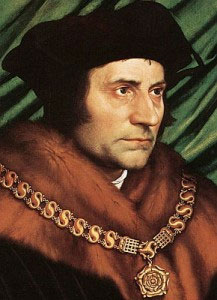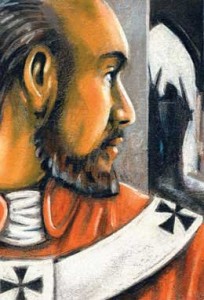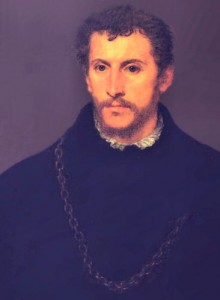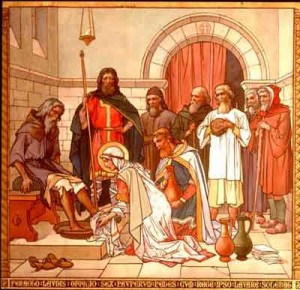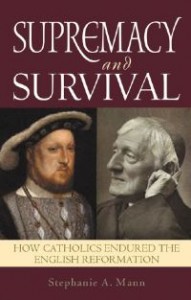I leave it to Omar F. A. Gutierrez to write so well on the life,  times, and death of this great saint.
times, and death of this great saint.
You may perhaps remember a scene from Braveheart with Robert the Bruce and his father the leper.
When his son first brings him news about the rebellion led by William Wallace, a commoner, the father instantly devises a plan by which the Bruce clan can gain favor with the Scots and with the English. You get the feeling that Robert is a bit taken aback by the so easy and cold calculation of his rotted father.
He says,
This Wallace. He doesn’t even have a knighthood. But he fights with passion, and he is clever. He inspires men.
His father replies:
You admire him. Uncompromising men are easy to admire. He has courage. So does a dog. But you must understand this: Edward Longshanks is the most ruthless king ever to sit on the throne of England, and none of us, and nothing of Scotland, will survive unless we are as ruthless, more ruthless, than he.
“Uncompromising men are easy to admire.†There is in this world, and it seems more so today, a habit of admiring the compromising fellow. With the ubiquitous dictatorship of relativism that oppresses so many minds, it only makes sense that the general public would take offense at anyone who dares stand up for something with uncompromising stolidity.
The holder of objective truth claims is – so the sages of Manhattan and Melrose Place tell us – no different than the Nazi who insists on the claim to racial purity or the Islamic bomber who literally does cling to his religion and guns.
For this reason, the figure of St. Thomas More, whose feast it is today, can be such a 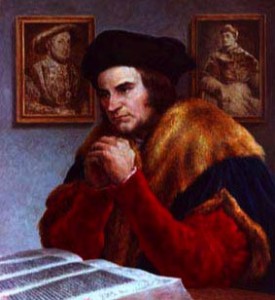 perplexing figure for the modern mind. And even the Catholic who consumes their breakfast whilst pouring over the latest moto proprio can miss this astonishingly great man. I have to admit having skipped over him in my studies, chalking him up with all the other saints and blesseds who gain God’s favor by losing their heads. But St. Thomas More is more than just a martyr.
perplexing figure for the modern mind. And even the Catholic who consumes their breakfast whilst pouring over the latest moto proprio can miss this astonishingly great man. I have to admit having skipped over him in my studies, chalking him up with all the other saints and blesseds who gain God’s favor by losing their heads. But St. Thomas More is more than just a martyr.
He’s an example of such exquisite lack of compromise that he can teach us a great deal about the Catholic Social Doctrine we long to understand and live out. (more…)
Tags: children, england, english reformation, love, martyr, martyrdom, protestant reformation, tudors
This entry was posted on Saturday, June 22nd, 2013 at 6:32 am
You can follow any responses to this entry through the RSS 2.0 feed.
Persecution of Catholics in England
[powerpress “faith-check-with-greg-youell”]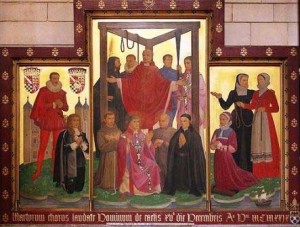
You’ve heard how the Pilgrims fled religious persecution in England, but have you ever heard how Catholics were persecuted there?
Recent scholarship such as Eamon Duffy’s book The Stripping of the Altars show that the vast majority of the English people did not freely choose to leave the Catholic Church, but were coerced into it. In fact, prior to King Henry VIII’s break with Rome, England was known throughout Europe as “Mary’s Dowry†because of its great piety. But under King Henry, Queen Elizabeth I, and others, failure to outwardly conform to the new state religion resulted in fines or imprisonment. Hiding a Catholic priest was considered a treasonable act punishable by death. Many suffered dearly, including famous martyrs like Sir Thomas More, or the 40 English martyrs that Pope John Paul II canonized.
Those openly professing Catholicism were barred from important positions in government and society well into the 1800s, and English law to this day prohibits a monarch from being Catholic.
Convincing evidence also shows that William Shakespeare was one such underground Catholic and that his plays included veiled appeals to the Queen for religious toleration.
So let us thank God that we can freely and openly practice our Faith, and honor all those who could not.
Tags: catholic, catholic podcast, catholic prayer, cathollc spirituality, england, martyrs of england
This entry was posted on Monday, January 2nd, 2012 at 7:16 am
You can follow any responses to this entry through the RSS 2.0 feed.
And what would happen next………
.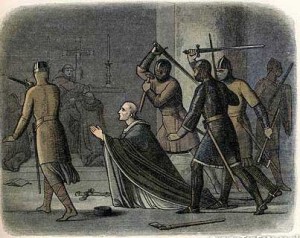
A strong man who wavered for a moment, but then learned one cannot come to terms with evil and so became a strong churchman, a martyr and a saint—that was Thomas Becket, archbishop of Canterbury, murdered in his cathedral on December 29, 1170.
His career had been a stormy one. While archdeacon of Canterbury, he was made chancellor of England at the age of 36 by his friend King Henry II. When Henry felt it advantageous to make his chancellor the archbishop of Canterbury, Thomas gave him fair warning: he might not accept all of Henry’s intrusions into Church affairs. Nevertheless, he was made archbishop (1162), resigned his chancellorship and reformed his whole way of life!
Troubles began. Henry insisted upon usurping Church rights. At one time, supposing some conciliatory action possible, Thomas came close to compromise. He momentarily approved the Constitutions of Clarendon, which would have denied the clergy the right of trial by a Church court and prevented them from making direct appeal to Rome. But Thomas rejected the Constitutions, fled to France for safety and remained in exile for seven years. When he returned to England, he suspected it would mean certain death. Because Thomas refused to remit censures he had placed upon bishops favored by the king, Henry cried out in a rage, “Will no one rid me of this troublesome priest!†Four knights, taking his words as his wish, slew Thomas in the Canterbury cathedral.
Thomas Becket remains a hero-saint down to our own times. From Saint of the Day
For a greater telling of this saint’s life – EWTN Library
Note: T. S. Eliot wrote a play — “Murder in the Cathedral” — about his life, and a movie — “Becket” (1964) — starring Peter O’Toole and Richard Burton has been made, too
Prayer for St. Thomas a Becket
Taken from the Roman Missal.
O God, for the sake of whose Church the glorious Bishop Thomas fell by the sword of ungodly men: grant, we beseech Thee, that all who implore his aid, may obtain the good fruit of his petition. Through our Lord Jesus Christ, Who livest and reignest with Thee in the unity of the Holy Spirit, forever and ever. Amen.
Tags: archbishop of Canterbury, Archishop of Canterbury, Canterbury cathedral, catholic, catholic podcast, catholic prayer, cathollc spirituality, Church, england, Henry II, martyr, matyrdom, middle ages, St. Thomas Becket, Thomas Becket
This entry was posted on Thursday, December 29th, 2011 at 5:19 am
You can follow any responses to this entry through the RSS 2.0 feed.
Trial and execution
Committed to the Tower of London, he was questioned in the presence of Queen Elizabeth, who asked him if he acknowledged her to be the true Queen of England. He replied she was, and she offered him wealth and dignities, but on condition of rejecting his Catholic faith, which he refused to accept. He was kept a long time in prison and reputedly racked twice. Despite the effect of a false rumour of retraction and a forged confession, his adversaries summoned him to four public conferences (September 1, 18, 23 and 27, 1581). Although still suffering from his ill treatment, and allowed neither time nor books for preparation, he reportedly conducted himself so easily and readily that he won the admiration of most of the audience. Tortured again on October 31, he was indicted at Westminster on a charge of having conspired, along with others, in Rome and Reims to raise a sedition in the realm and dethrone the Queen.
Edmund Campion, in a 1631 print.Campion was sentenced to death as a traitor. He answered: “In condemning us, you condemn all your own ancestors, all our ancient bishops and kings, all that was once the glory of England — the island of saints, and the most devoted child of the See of Peter.” He received the death sentence with the Te Deum laudamus. After spending his last days in prayer he was led with two companions, Ralph Sherwin and Alexander Briant, to Tyburn where the three sainted martyrs were hanged, drawn and quartered on December 1, 1581. He was 41 years of age.
Veneration and Feast Day
Edmund Campion was beatified by Pope Leo XIII on December 9, 1886. Blessed Edmund Campion was canonized nearly eighty-four years later in 1970 by Pope Paul VI as one of the Forty Martyrs of England and Wales with a common feast day of May 4. His feast day is celebrated on December 1, the day of his martyrdom.
The actual ropes used in his execution are now kept in glass display tubes at Stonyhurst College in Lancashire; each year they are placed on the altar of St Peter’s Church for Mass to celebrate Campion’s feast day—which is always a holiday for the school. – wiki
A Daily Prayer of St. Edmund
“I have made a free oblation of myself
to your Divine Majesty,
both of life and of death,
and I hope that
you will give me
grace and force to perform.
This is all I desire. Amen.”
-St. Edmund Campion
Tags: Blessed Edmund Campion, catholic, catholic podcast, catholic prayer, cathollc spirituality, death, edmund campion, england, feast day, Feast Day Edmund Campion, martyr, martyrdom, martyrs of england, queen elizabeth, Queen of England, saints
This entry was posted on Thursday, December 1st, 2011 at 12:02 am
You can follow any responses to this entry through the RSS 2.0 feed.
A Queen of Scotland!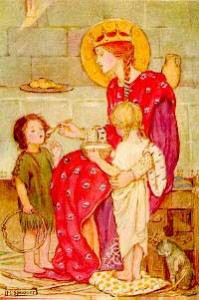
Margaret was born c. 1045 and was the niece of King Edward the Confessor of England. She was raised in Hungary and lived with her exiled father, Edward Atheling, her mother, Agatha, her brother, Edgar, and her sister, Christian. They returned to England in 1054. Early chronicles tell us that she read the scriptures in Latin, learned French and was trained in English needlework.
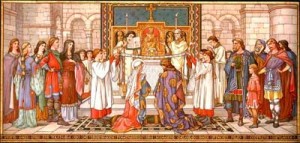 Marriage of St Margaret
Marriage of St MargaretMargaret married Malcolm III ‘Canmore’ of Scotland in c.1070. Margaret would have been about 24 years of age and Malcolm about 47. Ancient chronicles tell us that Margaret was more prepared for the cloister than the crown. However, Malcolm won her over and they were married in Dunfermline, then the seat of the Scottish kings.
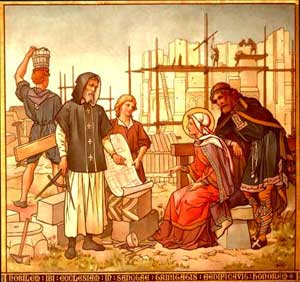
Margaret had a significant influence on early Scotland. Although she was a patron of the existing celtic church, she also introduced to Scotland the Benedictines from Canterbury and had the Priory Church built which would eventually become Dunfermline Abbey. Margaret also had a chapel built at Edinburgh Castle and the church at Iona rebuilt after Viking attacks.
Washing the feet of the poor
Margaret was very pious and carried out many works of charity. She visited and cared for the sick and had hostels built for the poor. It was her custom that the poor should visit her every morning and be seated around her to receive alms. (more…)
Tags: benedictine, catholic, catholic podcast, catholic prayer, cathollc spirituality, celtic church, england, Malcolm III, mother, scotland, st margaret, St Margaret Margaret, St. Margaret of Scotland, women of the middle ages
This entry was posted on Wednesday, November 16th, 2011 at 12:04 am
You can follow any responses to this entry through the RSS 2.0 feed.
“Supremacy and Survival: How Catholics Endured the English Reformation” is an outstanding introduction to the persecution of Catholics began in 16th century England. Lasting over 250 years, the effects can still be felt in some ways even in today’s world. But through the witness of great saints such as St. Thomas More and St. John Fisher to Blessed John Henry Newman, Catholics in England, as well as throughout the rest of the world, have been encouraged and inspired to continue standing for the truths found in the Catholic Church, which ultimately reflect the great Truth, who is Our Lord and Savior Jesus Christ. Stephanie Mann does a beautiful job of presenting this period and many of those heroic lives in her work.
outstanding introduction to the persecution of Catholics began in 16th century England. Lasting over 250 years, the effects can still be felt in some ways even in today’s world. But through the witness of great saints such as St. Thomas More and St. John Fisher to Blessed John Henry Newman, Catholics in England, as well as throughout the rest of the world, have been encouraged and inspired to continue standing for the truths found in the Catholic Church, which ultimately reflect the great Truth, who is Our Lord and Savior Jesus Christ. Stephanie Mann does a beautiful job of presenting this period and many of those heroic lives in her work.
To learn more visit Stephanie Mann’s website
[powerpress]
Tags: 16th century, catholic, catholic church, catholic podcast, catholic prayer, cathollc spirituality, england, english reformation, John Fisher, john henry newman, st john fisher, st thomas more, Stephanie Mann, work
This entry was posted on Tuesday, October 12th, 2010 at 4:14 am
You can follow any responses to this entry through the RSS 2.0 feed.

